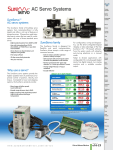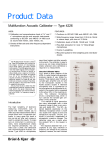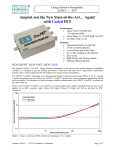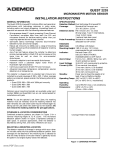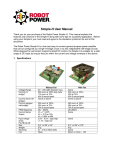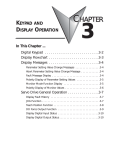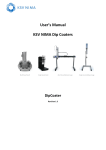Download Chapter 7 - AutomationDirect
Transcript
MAINTENANCE AND TROUBLESHOOTING CHAPTER 7 In This Chapter ... Maintenance and Inspection . . . . . . . . . . . . . . . . .7–2 Basic Inspection . . . . . . . . . . . . . . . . . . . . . . . . . . . . . . . . . . . . .7–2 Maintenance . . . . . . . . . . . . . . . . . . . . . . . . . . . . . . . . . . . . . . . .7–3 Expected Life of Replacement Components . . . . . . . . . . . . . . . .7–3 Troubleshooting . . . . . . . . . . . . . . . . . . . . . . . . . . .7–4 Fault & Warning Message Table . . . . . . . . . . . . . . . . . . . . . . . . .7–4 Fault Message Potential Causes and Corrective Actions . . . . . . . .7–5 Warning Message Potential Causes and Corrective Actions . . . . .7–9 Clearing Faults . . . . . . . . . . . . . . . . . . . . . . . . . . . . . . . . . . . . .7–10 Chapter 7: Maintenance and Troubleshooting Maintenance and Inspection SureServo™ AC servo drives are based on solid state electronics technology. Preventive maintenance is required to make sure the drive functions properly and has a long life. We recommend that periodic maintenance and inspection of the servo drive be performed by a qualified technician. Always turn off the AC input power to the unit before any maintenance and inspection. WARNING: AC input power must be disconnected before performing any maintenance. Do not connect or disconnect wires or connectors to the servo drive or motor while power is applied to the circuit. Make sure that the internal capacitors have fully discharged (wait for the Charge LED to go off) before performing the maintenance and inspection! Maintenance must be performed by a qualified technician only. WARNING: A charge with hazardous voltages may still remain in the DC-link capacitor even if the power has been turned off. To avoid personal injury, do not remove the cover of the AC servo drive. There are no user serviceable parts inside the drive. Basic Inspection Item General Inspection Inspection Content Periodically inspect the mounting screws for the servo drive, motor shaft, terminal block, and the connection to mechanical system. Tighten screws as necessary; they may loosen due to vibration and temperature variation. Make sure that oil, water, metallic particles, or any foreign objects do not fall inside the servo drive, motor, control panel, or ventilation slots and holes. Make sure that the servo drive control panel has been installed correctly, and that it is free from airborne dust, harmful gases, or liquids. Make sure that all wiring instructions and recommendations are followed to prevent damage to the drive and/or motor. Make sure control switch is OFF. Make sure that all wiring terminals are correctly insulated. Inspection before operation (Control power not applied) Make sure that all wiring is correct to prevent damage and/or malfunction. Visually check to make sure that there are no unused screws, metal strips, or any conductive or flammable materials inside the drive. To avoid electric shock, be sure to connect the servo drive ground terminal to the control panel ground terminal. Before making any connection, wait 10 minutes for internal capacitors to discharge after power is disconnected. Never put flammable objects on servo drive or close to the external regenerative resistor. If the electromagnetic brake is being used, make sure that it is correctly wired. If required, use an appropriate electrical filter to eliminate noise to the servo drive. Inspection during operation (Control power applied) 7–2 Make sure that the external applied voltage to the drive is correct and matched to the controller. Make sure that the cables are not damaged, stressed excessively, or loaded heavily. When the motor is not running, check the cables and connections for damage, fraying, or over extension. Check for abnormal vibrations and sounds during operation. If the servo motor is vibrating or there are unusual noises while the motor is running, shut the motor down. Disconnect input power before troubleshooting the motor. Make sure that all user-defined parameters are set correctly. Reset parameters when the servo drive is off to prevent servo system malfunction. Check the power indicators and LED display for abnormal conditions. SureServo™ AC Servo Systems User Manual 2nd Ed, Rev B 08/2011 Chapter 7: Maintenance and Troubleshooting Maintenance • Use and store servo system in a clean, dry, and normal-temperature environment. • Periodically clean the surfaces and panel of servo drive and motor. • Periodically check the resistance of the insulation with Meg-ohmmeter. The insulation resistance should measure at least 100 Meg-Ohms at 500 VDC and should be tested with a power cable connector properly connected to the motor. • Periodically check the DC BUS filter capacitors and precharge relays after the warranty period, and replace if necessary. • Periodically check the conductors or insulators for corrosion and/or damage. • Do not disassemble or damage any mechanical part when performing maintenance. • Periodically clean off any dust and dirt with a vacuum cleaner, especially the ventilation ports and printed circuit boards. Always keep these areas clean; accumulation of dust and dirt can cause overheating and component failures. WARNING: To prevent serious injury or equipment damage, inspection and replacement of board-level components should be performed by qualified repair technicians experienced in board-level maintenance and repair. Expected Life of Replacement Components DC BUS Filter Capacitor DC BUS filter capacitor life varies according to ambient temperature and operating conditions. Excessive ripple currents will shorten capacitor life. The expected life is ten years when properly used in a clean, dry, air-conditioned environment. Precharge Relay The contacts will wear due to switching current; the common expected relay life is 100,000 operations. Cooling fan (SVA-2100 and SVA-2300 Models Only) The cooling fan should be checked periodically for adequate air flow, which is essential to prevent damage to the power stage. Replace fan immediately if it is vibrating or making unusual noises. 2nd Ed, Rev B 08/2011 SureServo™ AC Servo Systems User Manual 7–3 Chapter 7: Maintenance and Troubleshooting Troubleshooting Fault & Warning Message Table Once a fault or error is detected, the corresponding protective fault functions will be activated and the fault messages will be displayed. Fault/Warning Messages Display Fault/Warning Name TYPE Fault/Warning Description ALE 01 Overcurrent Fault Main circuit current is higher than 1.5 multiple of motor's instantaneous maximum current value. ALE 02 Overvoltage Fault Main circuit voltage has exceeded its maximum allowable value. (Main circuit voltage is higher than specification.) ALE 03 Undervoltage Fault Main circuit voltage has fallen below its minimum value. (Main circuit voltage is lower than specification.) ALE 04 Motor overheated Fault The motor's operating temperature is higher than the upper-limit of the specification. ALE 05 Regeneration error ALE 06 Overload ALE 07 Overspeed Fault Regeneration control operation is in error. Fault Servo motor and drive are overloaded. Fault Motor's control speed exceeds the limit set in P1-55. pulse control ALE 08 Abnormal command Fault Input frequency of pulse command exceeds the limit of its allowable set value. ALE 09 Excessive deviation Fault Position control deviation value exceeds the limit of its allowable set value. ALE 10 Watch dog execution time out Fault Watch dog execution time out. Fault Pulse signal is in error. ALE 11 Position detector error Components ALE 12 Internal Require Calibration ALE 13 Fault stop ALE 14 Reverse limit error ALE 15 Forward limit error ALE 16 IGBT temperature error ALE 17 Memory error ALE 18 DSP communication error ALE 19 Serial communication error ALE 20 Serial communication time out ALE 21 Command write-in error ALE 22 Input power phase loss Overload Output ALE 23 At Warning Threshold 7–4 Fault Internal Components Require Calibration Fault Fault stop switch is activated. Fault DI setting 22 reverse limit switch is activated. Fault DI setting 23 forward limit switch is activated. Fault IGBT is overheated. Fault EE-PROM write-in and read-out is in error. Fault DSP communication is in error. Fault RS232/422/485 communication is in error. Fault RS232/422/485 communication time out. Fault Control command write-in error. Fault One phase of the input power is lost. Warn Motor overload exceeds the time % set in P1-56. SureServo™ AC Servo Systems User Manual 2nd Ed, Rev B 08/2011 Chapter 7: Maintenance and Troubleshooting Fault Message Potential Causes and Corrective Actions ALE 01: Overcurrent Potential Cause Checking Method Corrective Actions Short-circuit at drive output Check the wiring connections between drive and motor, and check cables for Repair short-circuit. shorts. Motor wiring error Make sure the connections between the motor and drive are correct. Follow the wiring steps in the user manual to reconnect wiring. Control parameter setting error Check if the set value exceeds the factory default setting. Change the setting back to factory default, reset, and adjust the parameter setting again. Control command setting error Check if the control input command is Make sure that input command frequency is unstable (fluctuating too much). stable and activate filter function. IGBT error Heat sink overheated. Call Technical Support: 770-844-4200 ALE 02: Overvoltage Potential Cause Checking Method The main circuit voltage has Use voltmeter to check whether the exceeded its maximum input voltage falls within the rated allowable value input voltage. (incorrect power input). Corrective Actions Use correct power supply. ALE 03: Undervoltage Potential Cause Checking Method Corrective Actions The main circuit voltage has fallen below its minimum Check for proper input voltage wiring. value. Correct input wiring as needed. No input voltage at main circuit. Use voltmeter to check whether input voltage at main circuit is normal. Check input power supply, including switches and fuses. Input power error (Incorrect power input) Use voltmeter to check whether the input voltage is within the specified limit. Use correct power supply. ALE 04: Motor Overheated Potential Cause Corrective Actions Use thermometer to check the motor Re-size the capacity of motor and drive or temperature (motor external temperature reduce system demands (decrease speed, should not be above 158°F), and check increase accel/decel time). if servo system is overloaded. Servo system is overloaded. 2nd Ed, Rev B Checking Method 08/2011 SureServo™ AC Servo Systems User Manual 7–5 Chapter 7: Maintenance and Troubleshooting ALE 05: Regeneration Error Potential Cause Checking Method Regenerative resistor is Check the regenerative resistor wiring not connected. connections. Parameter setting error Confirm the parameter setting and specifications of regenerative resistor. Corrective Actions Connect regenerative resistor as needed. Correctly reset parameter again. ALE 06: Overload Potential Cause The drive has exceeded its rated load during continuous operation. Checking Method Check for drive overloading. Control system parameter Check for mechanical vibration. setting is incorrect. Accel/decel time setting is too fast. Motor and encoder wiring error. Check the wiring of U, V, W and encoder. Corrective Actions Increase motor capacity or reduce load. Adjust gain value of control circuit. Increase accel/decel time setting. Make sure all motor wiring is correct. ALE 07: Overspeed Potential Cause Checking Method Speed input command is Use signal detector to detect if input not stable (too much signal is abnormal. fluctuation). Over-speed parameter setting is defective. Corrective Actions Make sure that input command frequency is stable and activate filter function. Check if over-speed parameter setting Correctly set over-speed parameter setting. value is too low. ALE 08: Abnormal Pulse Control Command Potential Cause Pulse command frequency is higher than rated input frequency. Checking Method Use pulse frequency detector to measure input frequency. Incorrect pulse stream for Use oscilloscope to view incoming quadrature input. pulse stream. 7–6 Corrective Actions Correctly set the input pulse frequency. Correct incoming pulse stream. SureServo™ AC Servo Systems User Manual 2nd Ed, Rev B 08/2011 Chapter 7: Maintenance and Troubleshooting ALE 09: Excessive Deviation Potential Cause Checking Method Corrective Actions Maximum deviation Check the maximum deviation parameter setting is too small. parameter setting. Increase parameter setting value. Gain value is too small. Check if the setting value is correct. Correctly adjust gain value. Torque limit is too low. Check torque limit value. Correctly adjust torque limit value. There is an overload. Check for overload condition. Reduce external applied load or re-size the motor capacity. Profile is too demanding. Increase Accel/Decel times to see if Increase Accel/Decel or resize motor ramp is too steep. capacity. One or more Position Velocity Check whether the value of any parameter is set greater than P2-36 ~ P2-43 is greater than the Maximum Velocity Limit the value of P1-55. parameter. Set all of the Position Velocity parameters less than or equal to the Maximum Velocity LImit. ALE 10: Watch Dog Execution Time Out Potential Cause Checking Method Watchdog execution error. Check and reset the power supply. Corrective Actions If there are any abnormal conditions after resetting the power supply, call Technical Support: 770-844-4200 ALE 11: Position Dectector Error Potential Cause Checking Method Corrective Actions Encoder wiring error. Check to make sure the wiring is correct and that all connections are tight; refer to the wiring information in this user manual. Encoder is damaged. Using oscilloscope, check encoder for Repair or replace motor. damage. Correct any wiring errors. ALE 12: Internal Components Require Calibration Potential Cause Internal component calibration Checking Method Restore to default configuration. Corrective Actions If the error does not clear after restoring the drive to default settings, contact Technical Support: 770-844-4200 ALE 13: External Fault Stop Potential Cause Checking Method Fault stop input is activated. Check if fault stop switch is On or Off. 2nd Ed, Rev B 08/2011 Corrective Actions Clear and reset fault input. SureServo™ AC Servo Systems User Manual 7–7 Chapter 7: Maintenance and Troubleshooting ALE 14: Reverse Limit Error Potential Cause Checking Method Corrective Actions Reverse limit switch is activated. Check if reverse limit switch is On or Off. Move load in forward direction to deactivate limit switch, and reset fault. Servo system is not stable. Check the value of control parameter setting and load inertia. Modify parameter setting and re-size motor capacity. ALE 15: Forward Limit Error Potential Cause Checking Method Corrective Actions Forward limit switch is activated Check if forward limit switch is On or Off. Move load in reverse direction to deactivate limit switch, and reset fault. Servo system is not stable. Check the value of control parameter setting and load inertia. Modify parameter setting and re-size motor capacity. ALE 16: IGBT Temperature Error Potential Cause Checking Method Corrective Actions The drive has exceeded its Check for an overload, or if the motor rated load during continuous current is too high. operation. Increase motor capacity or reduce load. Short-circuit at drive output Make sure it is wired correctly. Check the drive input wiring. ALE 17: Memory Error Potential Cause Checking Method Data error in Memory readReset parameter or power supply. out / write-in. Corrective Actions If the error does not clear after resetting the parameter or power supply, contact Technical Support: 770-844-4200. ALE 18: DSP Communication Error Potential Cause Control power error. Checking Method Check and reset control power. Corrective Actions If the error does not clear after resetting the power supply, contact Technical Support: 770-844-4200. ALE 19: Serial Communication Error Potential Cause Checking Method Corrective Actions Communication parameter setting is not correct. Check communication parameter setting. Set parameter setting to correct value. Communication address is not correct. Check communication address. Set communication address to correct value. Communication setting value is not correct. Check read-out and write-in value. Set communication setting to correct value. 7–8 SureServo™ AC Servo Systems User Manual 2nd Ed, Rev B 08/2011 Chapter 7: Maintenance and Troubleshooting ALE 20: Serial Communication Time Out Potential Cause Checking Method Corrective Actions Set value in time out parameter is not correct. Check the time out parameter setting. Set parameter to correct value. Not receiving communication command. Check whether communication cable is loose or broken Tighten or repair communication cable. ALE 21: Command Write-in Error Potential Cause Control power supply error. Checking Method Corrective Actions If the error does not clear after resetting Check and reset control power supply. the power supply, contact Technical Support: 770-844-4200. ALE 22: Input Power Phase Loss Potential Cause Input power error. Checking Method Check for poor input power line connection, or for possible loss of phase on input power line. Corrective Actions Correctly connect three-phase power. Warning Message Potential Causes and Corrective Actions ALE 23 (Warning): At Overload Output Warning Threshold Potential Cause Overload time exceeds the Overload Output Warning Treshold. 2nd Ed, Rev B 08/2011 Checking Method Check value of P1-56 overload time. Corrective Actions This ALE is a warning, rather than a fault. It does not have to be cleared. SureServo™ AC Servo Systems User Manual 7–9 Chapter 7: Maintenance and Troubleshooting Clearing Faults Display Fault Name How to Clear Fault ALE 05 ALE 06 ALE 07 Regeneration error Turn Alarm Reset (DI signal) ON to clear the fault. Overload Turn Alarm Reset (DI signal) ON to clear the fault. Overspeed Turn Alarm Reset (DI signal) ON to clear the fault. ALE 08 Abnormal pulse control command Turn Alarm Reset (DI signal) ON to clear the fault. ALE 09 ALE 10 Excessive deviation Turn Alarm Reset (DI signal) ON to clear the fault. Watch dog execution time out This fault information cannot be cleared. ALE 11 Position detector error This fault condition can be removed (or reset) only by cycling control power to the servo drive. ALE 12 Internal Components Require Calibration Restore to default configuration. ALE 13 Fault stop This fault information can be removed automatically by resetting Fault Stop Input (DI signal). ALE 14 Forward limit error Move load in forward direction to deactivate limit switch. Turn Alarm Reset (DI signal) ON or turn off the servo drive to clear the fault. ALE 15 Reverse limit error Move load in forward direction to deactivate limit switch. Turn Alarm Reset (DI signal) ON or turn off the servo drive to clear the fault. ALE 16 ALE 17 ALE 18 ALE 19 ALE 20 ALE 21 ALE 22 IGBT temperature error Turn Alarm Reset (DI signal) ON to clear the fault. Memory error Turn Alarm Reset (DI signal) ON to clear the fault. DSP communication error Turn Alarm Reset (DI signal) ON to clear the fault. Serial communication error Turn Alarm Reset (DI signal) ON to clear the fault. Serial communication time out Turn Alarm Reset (DI signal) ON to clear the fault. Command write-in error Turn Alarm Reset (DI signal) ON to clear the fault. Input power phase loss Turn Alarm Reset (DI signal) ON to clear the fault. ALE 23 At Overload Output Warning Threshold This ALE is a warning rather than a fault, and therefore does not have to be cleared. For drive firmware v2.10 and higher, active faults can be reset from the keypad. Press and hold the UP and DOWN Arrow Keys simultaneously for two seconds to clear the fault. 7–10 SureServo™ AC Servo Systems User Manual 2nd Ed, Rev B 08/2011










